Harman Back On Top In Southeast
 Mark Harman made a statement that he is still a force to be reckoned with at GlenLakes Country Club in Weeki Wachee, Florida, this past May. The reigning World Cup champion from Ridgeland, South Carolina, set a Southeast Region Championship scoring record of seven under par to best Ron Cox of Henderson, Tennessee, by five shots. Richard Crowell from Pensacola, Florida, and Rich Lively of Rockledge, Florida, took third and fourth, grabbing the balance from the $1,200 purse. Thanks goes out to GlenLakes head pro Tom McCrary, who has hosted us for several years.
Mark Harman made a statement that he is still a force to be reckoned with at GlenLakes Country Club in Weeki Wachee, Florida, this past May. The reigning World Cup champion from Ridgeland, South Carolina, set a Southeast Region Championship scoring record of seven under par to best Ron Cox of Henderson, Tennessee, by five shots. Richard Crowell from Pensacola, Florida, and Rich Lively of Rockledge, Florida, took third and fourth, grabbing the balance from the $1,200 purse. Thanks goes out to GlenLakes head pro Tom McCrary, who has hosted us for several years.


 USGTF member Walt Abraham, head golf coach of Athenian High School in Danville, California, led his squad to the BCL-East league round-robin regular season title and also the league post-season tournament title. The team finished 9-1 in match play and next heads to the Division 2 championship tournament. The league title marks the seventh time in Abraham’s 11 seasons as head coach that Athenian has taken that honor. Athenian fields a young squad of three freshmen, one sophomore and two juniors, with three players earning all-league honors.
USGTF member Walt Abraham, head golf coach of Athenian High School in Danville, California, led his squad to the BCL-East league round-robin regular season title and also the league post-season tournament title. The team finished 9-1 in match play and next heads to the Division 2 championship tournament. The league title marks the seventh time in Abraham’s 11 seasons as head coach that Athenian has taken that honor. Athenian fields a young squad of three freshmen, one sophomore and two juniors, with three players earning all-league honors.  Cole Golden shot an opening round 69 against a strong field that featured several current and past USGTF champions at a windy Ridgeview Ranch Golf Course, which hosted the USGTF Southwest Region Championship May 4-5 in Plano, Texas. Tough, tricky greens and somewhat wet conditions after several days of wet weather had hit Texas earlier in the week greeted the competitors. Southwest Region director Bruce Sims and Master Lee carded 76 the first day, while Brent Davies and Chris Tyner shot 77. Grant Gulych, Jeff Kennedy, and D.B. Merrill came in with 78.
Cole Golden shot an opening round 69 against a strong field that featured several current and past USGTF champions at a windy Ridgeview Ranch Golf Course, which hosted the USGTF Southwest Region Championship May 4-5 in Plano, Texas. Tough, tricky greens and somewhat wet conditions after several days of wet weather had hit Texas earlier in the week greeted the competitors. Southwest Region director Bruce Sims and Master Lee carded 76 the first day, while Brent Davies and Chris Tyner shot 77. Grant Gulych, Jeff Kennedy, and D.B. Merrill came in with 78.
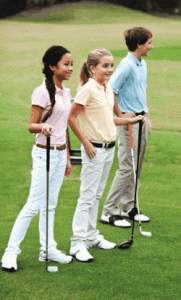 By Graham Lewis, USGTF Teaching Professional Townsend, Georgia
By Graham Lewis, USGTF Teaching Professional Townsend, Georgia
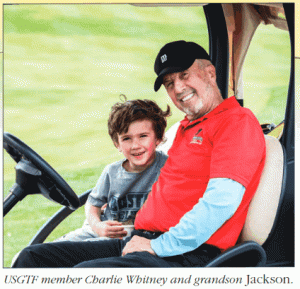 What are the first memories that you have of golf? If you started the game as a kid, they probably have to do with a family member – usually a parent – who introduced the game to you. Many golfers look back on those days with great fondness and nostalgia.
What are the first memories that you have of golf? If you started the game as a kid, they probably have to do with a family member – usually a parent – who introduced the game to you. Many golfers look back on those days with great fondness and nostalgia.
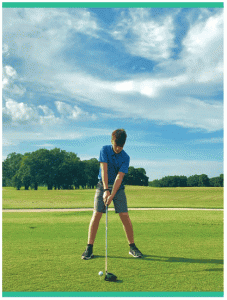

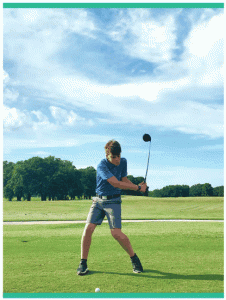

 By David Vaught, USGTF Teaching Professional Bradenton, Florida
By David Vaught, USGTF Teaching Professional Bradenton, Florida
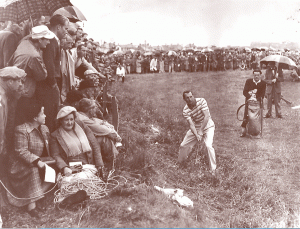 By Mike Stevens, USGTF Teaching Professional Tampa, Florida
By Mike Stevens, USGTF Teaching Professional Tampa, Florida
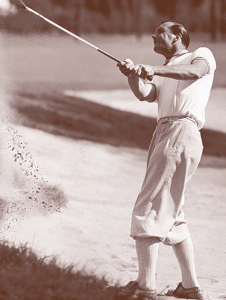 Here is where the story gets even more interesting. After a brief respite, Max headed for the first tee. As he walked, a young boy approached and asked him to sign a ball, but Faulkner was reluctant, not wanting to be distracted. Then the boy said, “You’re going to win,” and at the urging of the boy’s father who mentioned how much it would mean to the boy, Max signed the ball – Max Faulkner, Open Champion 1951. For the first time, he let the thought of blowing a big lead enter his mind, and struggled a bit coming home in 74. There were no scoreboards at the time, so runners were dispatched to and from to let people know what was going on with players still on the course. Word came in that Tony Cerda had turned in 34 and was a threat to catch the leader. A bit later, the word was that three fours on the final holes would tie Faulkner. A final messenger approached Max and related to him, “Cerda’s taken six; it’s your Open.”His dream had proved true – he was the Champion Golfer of the Year. The Claret Jug held by South African Bobby Locke would be returning to Britain.
Here is where the story gets even more interesting. After a brief respite, Max headed for the first tee. As he walked, a young boy approached and asked him to sign a ball, but Faulkner was reluctant, not wanting to be distracted. Then the boy said, “You’re going to win,” and at the urging of the boy’s father who mentioned how much it would mean to the boy, Max signed the ball – Max Faulkner, Open Champion 1951. For the first time, he let the thought of blowing a big lead enter his mind, and struggled a bit coming home in 74. There were no scoreboards at the time, so runners were dispatched to and from to let people know what was going on with players still on the course. Word came in that Tony Cerda had turned in 34 and was a threat to catch the leader. A bit later, the word was that three fours on the final holes would tie Faulkner. A final messenger approached Max and related to him, “Cerda’s taken six; it’s your Open.”His dream had proved true – he was the Champion Golfer of the Year. The Claret Jug held by South African Bobby Locke would be returning to Britain.
